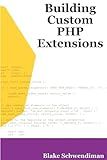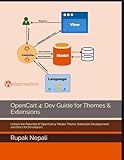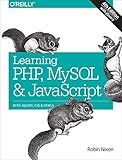Best PHP Extension Tools to Buy in October 2025

Building Custom PHP Extensions
- QUALITY ASSURANCE: ALL BOOKS ARE CHECKED FOR GOOD CONDITION.
- AFFORDABLE PRICES: SAVE MONEY WHILE ENJOYING GREAT READS.
- ECO-FRIENDLY CHOICE: SUPPORT SUSTAINABILITY BY BUYING USED BOOKS!



OpenCart 4: Dev Guide for Themes & Extensions: Unlock the Potential of OpenCart 4: Master Theme, Extension Development, and Docs for Developers



PHP für Einsteiger in 10 Lektionen: Programmieren lernen, schnell und effektiv (German Edition)



Learning PHP, MySQL & JavaScript: With jQuery, CSS & HTML5 (Learning Php, Mysql, Javascript, Css & Html5)



Learning Joomla! 3 Extension Development-Third Edition



WordPress - Développez avec PHP - extensions, widgets et thèmes avancés (4e édition)



WordPress - Développez avec PHP - extensions, widgets et thèmes avancés (théorie, TP, ressources) (3



Build Your Own Database Driven Web Site Using PHP & MySQL
- QUALITY ASSURANCE: EACH BOOK IS CAREFULLY INSPECTED FOR GOOD CONDITION.
- AFFORDABLE SAVINGS: GET QUALITY READS AT A FRACTION OF THE NEW PRICE.
- ECO-FRIENDLY CHOICE: SUPPORT SUSTAINABILITY BY CHOOSING USED BOOKS.



Drupal 8 Module Development: Build and customize Drupal 8 modules and extensions efficiently


To enable or disable PHP extensions in XAMPP, you can follow these steps:
- Open the XAMPP control panel and make sure your Apache web server and MySQL database server are running.
- Locate the "php.ini" file, which is typically found in the "php" folder within your XAMPP installation directory. The exact path may vary depending on your operating system.
- Open the "php.ini" file using a text editor like Notepad.
- To enable an extension, search for the line that begins with "extension=" in the "php.ini" file. Remove the semicolon (;) in front of the extension you want to enable. For example, to enable the PDO extension, find the line ";extension=pdo" and remove the semicolon so it becomes "extension=pdo".
- To disable an extension, locate the line that begins with "extension=" and add a semicolon (;) at the beginning of the line. For instance, to disable the cURL extension, find the line "extension=curl" and update it to ";extension=curl". Adding a semicolon comments out the line, effectively disabling the extension.
- Save the changes you made to the "php.ini" file.
- Restart the Apache web server from the XAMPP control panel to apply the changes. You can do this by clicking the "Stop" button next to Apache and then clicking the "Start" button again.
After following these steps, the PHP extensions should be enabled or disabled based on your modifications to the "php.ini" file in XAMPP.
How to enable the exif PHP extension in XAMPP?
To enable the exif PHP extension in XAMPP, follow these steps:
- Locate the php.ini file: In XAMPP, the php.ini file is typically located in the "php" folder within the XAMPP installation directory. The exact path may vary depending on your specific installation.
- Open the php.ini file in a text editor.
- Search for the following line in the php.ini file: ";extension=exif". This line is commented out by default, which means the exif extension is disabled.
- Remove the semicolon (;) at the beginning of the line to uncomment it, like this: "extension=exif".
- Save the php.ini file and close it.
- Restart the Apache server: Open the XAMPP Control Panel, stop the Apache server, and then start it again. This will ensure the changes take effect.
- Verify the extension: Create a new PHP file, for example, test.php, and add the following code to it:
Save the file and place it in the "htdocs" folder of your XAMPP installation.
- Open your web browser and navigate to http://localhost/test.php. This will display the PHP information page.
- Search the page for "exif". If you see a section called "EXIF Support", it means the exif extension is enabled and working correctly.
That's it! The exif extension should now be enabled in XAMPP.
How to troubleshoot issues with PHP extensions in XAMPP?
Here are some steps to troubleshoot issues with PHP extensions in XAMPP:
- Verify the extension is enabled: Check the php.ini configuration file to ensure the extension is not commented out. Open the php.ini file located in the XAMPP installation directory (e.g. xampp/php/php.ini) and search for the extension entry. Remove the semicolon at the beginning of the line if it exists.
- Restart the Apache server: After modifying the php.ini file, restart the Apache server for the changes to take effect.
- Verify the extension is present: Check if the extension file exists in the XAMPP PHP extension directory. The default location is xampp/php/ext. Make sure the extension DLL or .so file is present.
- Check for conflicts: Some PHP extensions may conflict with each other or with certain PHP versions. Disable other extensions one by one and restart the server to see if the issue is resolved. If there is a conflict, you may need to find an alternative or updated version of one of the conflicting extensions.
- Check for compatibility: Ensure that the PHP extension is compatible with your PHP version and XAMPP version. Some extensions may require a specific PHP version or architectural compatibility (32-bit vs 64-bit).
- Check error logs: Examine the Apache error logs and PHP error logs to see if any specific error messages related to the extension are being logged. The log files can be found in the xampp/apache/logs directory and the xampp/php/logs directory respectively.
- Reinstall the extension: If none of the above steps resolve the issue, try reinstalling the PHP extension. Download the latest version of the extension from a trusted source and follow the installation instructions provided.
Remember to always make backups of important files before making modifications, and consult official documentation or forums for the specific extension you are troubleshooting for more detailed instructions.
What is the function of the gettext PHP extension in XAMPP?
The gettext PHP extension in XAMPP is used for internationalization and localization purposes. It provides a set of functions and tools for handling multilingual and regionalized applications.
The main function of the gettext extension is to simplify the process of translating and displaying messages in different languages. It allows developers to mark strings in their code that need to be translated, and then provides functions to generate translated versions of those strings based on the user's selected language.
The gettext extension also provides support for plural forms, message domains, and setting the language and locale for the application. It includes tools for extracting translatable strings from source code, and for generating translation files in various formats.
Overall, the gettext extension in XAMPP enhances the internationalization capabilities of PHP applications, making it easier to create multi-language and region-specific versions of software.
What is the impact of enabling the pdo_sqlite PHP extension in XAMPP?
Enabling the pdo_sqlite PHP extension in XAMPP brings several impacts:
- SQLite database support: The pdo_sqlite extension allows PHP applications to connect, query, and manage SQLite databases. SQLite is a lightweight and serverless database engine that provides a fast and easy-to-use solution for local data storage.
- Increased compatibility: Enabling pdo_sqlite ensures compatibility with PHP frameworks and applications that rely on SQLite database functionality. Many popular frameworks, such as Laravel and Symfony, utilize the PDO (PHP Data Objects) abstraction layer, which pdo_sqlite enables.
- Flexibility in database selection: PDO provides a consistent interface for working with different database systems, including SQLite, MySQL, PostgreSQL, etc. By enabling pdo_sqlite, you can switch between different database backends easily by simply changing the connection configuration.
- Performance considerations: SQLite is designed for local, lightweight usage. It performs well for small to medium-sized applications or when a full-fledged database server is not required. However, it may not be suitable for massive concurrent access or high-traffic websites. Performance considerations should be taken into account before choosing SQLite as the database backend.
- Security considerations: SQLite databases are stored as files on the filesystem. Ensure appropriate security measures, such as properly securing the file permissions and avoiding direct access to the database file, to protect the data.
Overall, enabling the pdo_sqlite PHP extension in XAMPP expands the range of database options, increases compatibility with frameworks, and enables the use of SQLite databases for local data storage in PHP applications.
